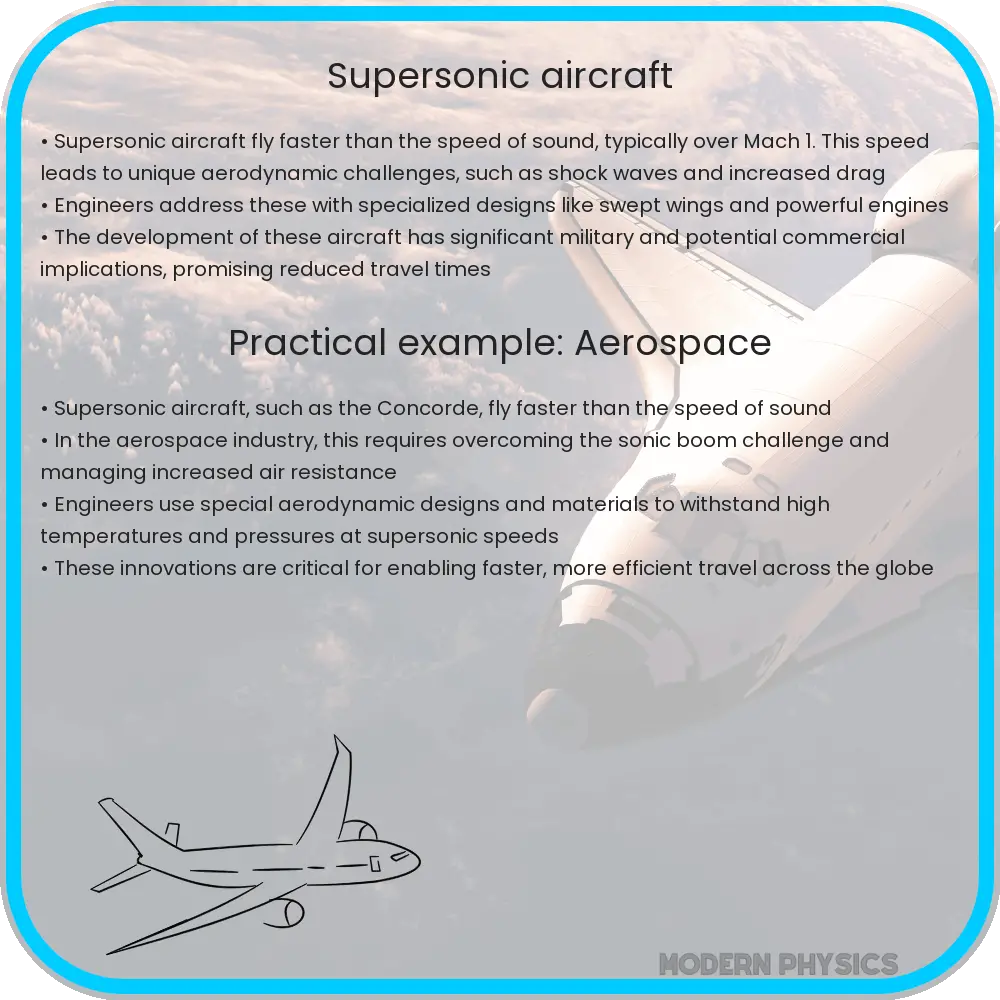Explore the fascinating world of supersonic aircraft, delving into their speed, aerodynamic design, and fluid dynamics in modern aviation.

Exploring the World of Supersonic Aircraft: Speed, Design, and Fluid Dynamics
Supersonic aircraft represent the pinnacle of aerodynamic engineering, pushing the boundaries of speed, design, and fluid dynamics. These aircraft travel faster than the speed of sound, a feat that involves overcoming significant physical challenges and leveraging advanced technological innovations.
Understanding Supersonic Speed
Supersonic speed is defined as a velocity that exceeds the speed of sound in air, which is approximately 343 meters per second (1,125 feet per second) at sea level, or about 1,235 kilometers per hour (767 miles per hour). This speed is also referred to as Mach 1, named after Ernst Mach, a physicist who studied gas dynamics. When aircraft exceed this speed, they enter the realm of supersonic flight.
Design Challenges of Supersonic Aircraft
Designing a supersonic aircraft involves addressing several complex challenges, primarily related to aerodynamics, materials, and propulsion. The most significant hurdle is overcoming the sonic boom, a loud shockwave created when an object moves through the air faster than the speed of sound. To mitigate this, supersonic aircraft typically feature sleek, streamlined designs with sharp edges and thin wings, known as delta wings, which reduce drag and enhance stability at high speeds.
Fluid Dynamics and Supersonic Flight
At supersonic speeds, the behavior of air and other fluids around the aircraft changes drastically. Supersonic aircraft must be designed to efficiently manage these changes. Aerodynamic heating, caused by air friction at high speeds, is a critical concern. The aircraft’s surface can reach extremely high temperatures, necessitating the use of heat-resistant materials like titanium and advanced composites.
Another key aspect of fluid dynamics in supersonic flight is managing shockwaves and pressure changes. Aircraft must be designed to handle the intense pressure and temperature changes that occur at these high speeds, especially during the transition through the sound barrier, known as transonic speed (Mach 0.8 to Mach 1.2).
Understanding and manipulating these fluid dynamics principles is crucial for the successful design and operation of supersonic aircraft. Advancements in computational fluid dynamics (CFD) have greatly aided engineers in predicting and analyzing the complex airflows involved in supersonic flight.
Advancements in Supersonic Technology
Recent advancements in supersonic technology have focused on improving efficiency, reducing environmental impact, and addressing the challenges of overland supersonic flight. Innovations in engine design, such as variable cycle engines, and the development of materials that can withstand higher temperatures and pressures are key to these advancements. Moreover, efforts are being made to reduce the sonic boom, opening up the possibility of overland supersonic travel without causing significant noise pollution.
Further Innovations in Supersonic Flight
The field of supersonic flight is not just about achieving higher speeds; it also focuses on enhancing efficiency and sustainability. Modern supersonic aircraft are being designed with more fuel-efficient engines and aerodynamic structures to minimize environmental impact. The integration of advanced composite materials has also contributed to lighter and stronger airframes, further improving fuel efficiency.
Another area of development is in the realm of passenger comfort and safety. Despite the primary focus on speed, ensuring a comfortable and safe experience for passengers is paramount. This includes innovations in cabin design, noise reduction, and vibration control, all of which are critical for long-duration supersonic flights.
Challenges and Future Prospects
Despite these advancements, supersonic flight faces several challenges. The high cost of development and operation remains a significant barrier. Additionally, environmental concerns, particularly the carbon footprint associated with high-speed travel, continue to be a major area of focus. Noise pollution, especially from sonic booms, also poses a challenge for overland flights.
Looking to the future, the potential for hypersonic flight (speeds exceeding Mach 5) presents a new frontier. Research in this area is advancing, with applications not only in aviation but also in space travel. The boundary between atmospheric flight and space exploration is becoming increasingly blurred, opening up exciting possibilities for faster-than-ever global travel and beyond.
Conclusion
Supersonic aircraft, a marvel of modern engineering, embody a remarkable synthesis of speed, design, and fluid dynamics. As technology continues to advance, these aircraft are evolving, becoming more efficient, environmentally friendly, and accessible. The challenges of supersonic flight are significant, but so are the opportunities. As engineers and scientists continue to push the boundaries of what is possible, the future of supersonic travel holds great promise, potentially transforming the way we connect with the world and beyond. This exciting field continues to evolve, driven by a relentless pursuit of innovation, efficiency, and a deeper understanding of the complex physics that govern high-speed flight.
